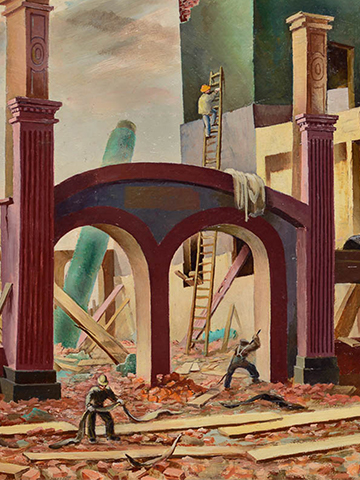Original Article published August 29, 2018 at 6:00 am, by The Seattle Times, written by Michael Upchurch
Seattle curator David F. Martin has been responsible for some of the most startling revivals of Pacific Northwest artists’ reputations in the past 10 years. Now comes “Drama and Design: Yvonne Twining Humber and Blanche Morgan Losey” at Cascadia Art Museum in Edmonds.
Exhibition review
Seattle curator David F. Martin has been responsible for some of the most startling revivals of Pacific Northwest artists’ reputations in the past 10 years.
He was the force behind the 2011 Henry Art Gallery show, “Shadows of a Fleeting World: Pictorial Photography and the Seattle Camera Club,” and it’s thanks to him that Tacoma photographer Virna Haffer and painter Z. Vanessa Helder enjoyed career retrospectives at the Tacoma Art Museum.
For years, Martin has worked as a freelance curator. But when the Cascadia Art Museum in Edmonds opened in 2015, Martin became its in-house curator. In the years since, his shows there have included “Northwest Social Realism and the American Scene: 1930-1950,” “Territorial Hues: The Color Print and Washington State, 1920-1960” and many more.
In an email exchange last week, Martin wrote: “Cascadia Art Museum has given me the opportunity to present exhibitions and publications to record my 30 years of research on the true history of Northwest art with an emphasis on women and minorities.”
Now comes “Drama and Design: Yvonne Twining Humber and Blanche Morgan Losey.” It’s fitting that Martin is taking a closer look at Humber because she was one of the first forgotten artists he tracked down after he and his partner moved to Seattle in 1986. He’d seen her paintings in East Coast museums, but no one here seemed to have heard of her. He learned her husband had died in 1960 and assumed that Humber herself, born in 1907, might also have passed away.
Then he found her name in the Seattle phone book, called her and asked, “Is this Yvonne Twining Humber, the artist?”
With a laugh, she replied, “I guess so.”
“Drama and Design” makes a strong case for Humber’s work. Her best oil paintings offer a beguiling blend of social realism and compositional whimsy. She had an especially appealing offbeat eye for the sights of downtown Seattle in the 1940s.
In “Demolition,” the building being razed looks like a dismantled, fabric-draped stage set, as tiny men scurry up ladders, rake through debris and load a dump truck. In “Business District,” she captures that delightful Seattle phenomenon: the steeply graded street that gives up the ghost and turns into a tangle of staircases. In “City View,” smokestacks and warehouses serve as an excuse to try out maverick color combinations. “Old Houses at Night” evokes tumbling visions of modest hillside homes.
Another sight that drew her eye was circuses. “Spoiled Carnival” depicts a rainstorm sweeping through crowded fairgrounds. “Circus Acts” is an antic epic with elephants, acrobats, clowns, trapeze artists and others, all doing their thing at once. “Performers’ Entrance” and “Closing Circus” take viewers behind the scenes, as their titles suggest. The work is figurative, but the color schemes and compositions are fanciful, as Humber delightfully heightens the scenes’ reality.
In her rural landscapes — “River Picnic,” “Chicken Yard,” “Summer on the Farm” — her eccentric touches include tree branches that make U-turns and landscapes that appear to heave and ripple.
Losey is just as eclectic an artist. Her paintings — mostly watercolors — range from realistic-with-a-twist to downright surreal. A crisp 1944 aerial survey of a farm landscape is made sinister by its title: “Bombardier’s View.” “Tired Harlequin” shows a Pierrot figure who seems to have become precariously disassembled and interlaced with an architectural ruin.
A whole room is devoted to Losey’s costume and stage designs for the Federal Theatre Project and Negro Repertory Company in Seattle in the 1930s. Martin notes that this part of the exhibit reveals “the significant contributions made by the regional black theater community” in Depression-era Seattle.
Along with Losey’s lively watercolor sketches for productions of Shakespeare’s “The Taming of the Shrew,” George Bernard Shaw’s “Androcles and the Lion” and a version of Aristophanes’ “Lysistrata” set in “the mythical state of Ebonia,” the show is packed with photographs and newspaper clips from the time, profiling such local African-American stars as Sara Oliver and Joe Staton. This is a lost chapter of Seattle theater history if ever there was one, and we’re lucky to have Martin uncovering it for us.
Original Article: https://www.seattletimes.com/entertainment/visual-arts/drama-and-design-brings-together-works-by-regional-artists-yvonne-twining-humber-and-blanche-morgan-losey/


